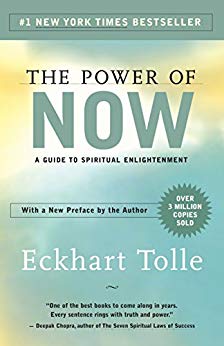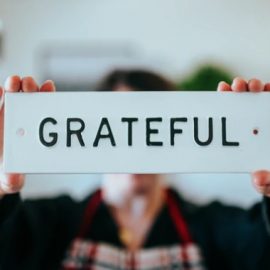

This article is an excerpt from the Shortform summary of "The Power of Now" by Eckhart Tolle. Shortform has the world's best summaries of books you should be reading.
Like this article? Sign up for a free trial here .
Do you find yourself not living in the present moment? Are you caught up in your own head, worrying about the future or running over the past?
Learn how to live in the present moment by appreciating the power of Now.
What is the power of Now? The Now is the present moment — each individual moment in the innumerable sequence of moments that makes up our lives. The power of Now is in experiencing each of these moments with your full and undivided attention, without being distracted by your internal monologue (whether that includes thoughts of your to-do list, replaying an interaction from this morning, or running commentary and analysis of the present).
By actively engaging in each moment, you can prevent much of your pain and stress and live in a consistent state of inner peace and fulfillment. We will explain how and why in later chapters.
Test Yourself: How to Live in the Present
Sounds easy? Set a timer for five minutes. Until the timer goes off, pay attention each time your thoughts drift to something besides what you are doing in that exact moment.
Staying completely focused on the present is a simple concept, but it is not necessarily easy; most of us have such a strong habit of getting carried away in our thoughts that it will take deliberate effort and practice to stay and live in the present moment.
Now Is the Only Time That Truly Exists
We give a lot of power and credence to the past and the future. We tend to think the past shaped us, and that the future holds our hope and salvation (or, perhaps, demise).
In reality, the past and future exist only in your mind. The past was Now when it happened, and the future will be Now when it happens. But in this moment, the past consists only of memories, and the future is purely speculation. Take a moment to wrap your head around that. This is key to how to live in the present moment.
- Consider this analogy: The moon does not radiate any light, but only reflects the light of the sun. The past and future have no reality of their own, but are only reflecting the light of the eternal Now.
When we think about the past or the future, it takes away from living in the present, which is the only true experience.
Much of our unhappiness is caused by putting too much mental energy and attention on the past and future, instead of living in the present moment. We don’t gain anything from dwelling on the past and future because we have no control over them — it’s too late to do anything about what happened in the past, and we can’t do anything about the future until it gets here (and when it does, we don’t even know if it will happen the way we expect).
The more we live in the past, the more we carry pain from past moments with us in the Now. Too much focus on the past creates guilt, regret, resentment, sadness, bitterness, and unforgiveness.
When we live in the future — always hoping and anticipating what may come later — we skip over experiencing the present. Neither of these is the key to how to live in the present moment.
Too much focus on the future creates anxiety, tension, stress, and worry. Jesus asked the disciples, “Can anxious thought add a single day to your life?”
Stress is so common that it’s practically considered a normal part of life, but in fact it is unnecessary. When you are so focused on getting to some point in the future (e.g. finishing a project or crossing off everything on your to-do list), living in the present becomes just a means to getting to the future. Stress is created by this inner split, when you are in the present but want to be in the future.
To avoid succumbing to stress, you can still move just as quickly and efficiently to get everything done without projecting all your thoughts into the future. Keep your focus and presence on each step you are taking to get there.
Don’t Wait to be Fulfilled – Live in the Present Moment
There are moments in life when we feel like we are at time’s will, when it feels as if there is nothing to do but wait — whether it’s for the traffic light to turn green or for your life to make a drastic turn. There are two types of waiting, based on whether you’re using clock time or psychological time: small-scale and large-scale.
Small-scale waiting is what you do in line at the post office or DMV. This form of waiting happens in clock time, and allows you to still be present.
- Use these situations — like waiting to check out at the grocery store or waiting to pick your child up from school or sports practice — as opportunities to be present. Give yourself that time to simply observe the sights and sounds around you, and for those few minutes try not to let your mind wander to your to-do list or that tense conversation you had with your coworker this morning.
Large-scale waiting is perpetually waiting for something that you think will make you happy or make your life more complete — like your next vacation, reaching a certain point of success in your career, or meeting the perfect partner.
Large-scale waiting is when you’re constantly waiting for the thing that will supposedly make you happy or fill a deeper void in your life. This is another psychological time trap. If you want to learn how to live in the present, you have to learn how to stop waiting for things.
Living in the Present Moment Requires Acceptance
If you are resisting some aspect of what exists in the Now, your focus is on how you wish the situation could be, or how it might improve later. You are not living in the present. Presence requires accepting what is — or surrendering to the Now — without judgment. (We’ll talk more about surrender in the next section.)
Examples of judgment are thinking, “I wish I were doing something besides working on this report right now,” or “I can’t believe I’m stuck in this long line at the post office.”
Even judging something as good (e.g. “I’m having a great day” or “This is going to be my best work yet”) creates a mindset of classifying things as either good or bad.
- We have a limited understanding of what is truly good and bad. Often, awakenings and forgiveness come only through pain and suffering first; the seemingly negative ultimately results in a positive (what some call a “blessing in disguise”).
- This is reinforced in the Bible’s Book of Genesis, where Adam and Eve were not allowed to stay in “paradise” once they “ate the tree of the knowledge of good and evil.”
Acceptance and presence are the only way to get through a difficult (or any) situation in life. You can’t go around it (avoidance) or go backward (time travel), so you must go through it, moment by moment. Learning this is key to how to live in the present moment.
How To Quiet the Voice In Your Head and Live in the Present
Many of us have an internal voice that keeps commenting about what we see and feel, and it prevents us from living in the present moment.
How do you disconnect from the voice inside your own head? It takes deliberate effort, attention, and practice.
As you are watching your thoughts, be mindful not to analyze or judge them. Those analytical or judgmental thoughts would be your ego slipping back in through the back door. Instead, simply observe.
As you start practicing, you will experience states of “no-mind” — also called presence or consciousness — when there is a pause in your thoughts and you are connected with your true self. (In contrast, when you are not present in the moment, you are under your ego’s control and are stuck in your thoughts.) These moments will be brief at first, but will extend with more practice.
Although your thoughts are quiet when you are present, it is a state of alertness and awareness of the present moment and of your true Being.
- When you are present you feel peace and inner stillness, though this is not a trance-like state like meditation. You actually become more alert and aware because you are solely and intensely focused on the Now. Sounds become more distinct, colors are more vivid, and the world is clearer without the white noise of your internal monologue.
You can practice living in the present present in your day-to-day life by putting your full attention on a routine, mindless task. Here are a few examples.
- When you walk up or down stairs, think about every step you take. Feel your body making every movement. Notice the warmth in your leg muscles. Pay attention to your breath.
- When you wash your hands, pay attention to the sound and feel of the water running over your hands. Focus on how you move your hands. Notice the smell of the soap. Feel the texture of the towel.
We are so accustomed to the ego’s control — and the low, constant hum of thoughts running through our mind — that it can be easy to overlook. To notice if you are present, ask yourself, “Am I feeling joy, ease, and lightness?” If the answer is no, then you are not present.
If that’s the case, you may not need to change what you are doing in that moment, but how you are doing it. Focus your complete attention on each minute detail of the task at hand to bring yourself back to the present.
———End of Preview———

Like what you just read? Read the rest of the world's best summary of "The Power of Now" at Shortform . Learn the book's critical concepts in 20 minutes or less .
Here's what you'll find in our full The Power of Now summary :
- Why you feel pain from the past, and how to get rid of it
- How to be more present and stop worrying about the future
- The 8 key ways to achieve mindfulness






